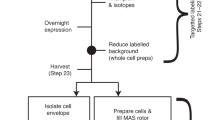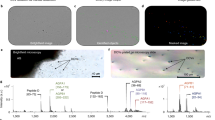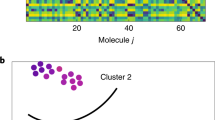Abstract
KNOWLEDGE of the state of many chemicals in cell compartments is based on inference from analytical methods carried out after partial or complete disruption of the cell. This situation arises as most of the cell contents have similar spectroscopic properties and cannot be studied inside a cell. We have shown that the contents of intact vesicles of the adrenal medulla (chromaffin granules) can be studied by nuclear magnetic resonance (NMR) in separated vesicles1. (We have subsequently shown (unpublished observations) that the spectra are quantitative and that all the adrenaline present in the granules is observed by NMR spectroscopy.) From this study1 we could establish an outline structure of the internal solution of these granules. The question then arises as to whether precisely this structure exists in the organelle within the cell or whether isolation of organelles such as these modified their properties. We report here that improved NMR methods can provide detailed information about the environment and mobility of small molecules and some proteins even within intact organs. As little as 10mg (dry weight) of tissue is required. No other technique can provide such information at present. Furthermore, the NMR data can be used to describe structural features of the organisation of the cell.
This is a preview of subscription content, access via your institution
Access options
Similar content being viewed by others
References
Daniels, A., Korda, A., Tanswell, P., Williams, A., and Williams, R. J. P., Proc. R. Soc., B 187, 353–361 (1974).
Campbell, I. D., Dobson, C. M., Williams, R. J. P., and Xavier, A. V., J. Magn. Resonance, 11, 172–181 (1973).
Campbell, I. D., Dobson, C. M., Williams, R. J. P., and Wright, P. E., FEBS Lett., 57, 96–99 (1975).
Sheetz, M. P., and Chan, S. I., Biochemistry, 11, 548–555 (1972).
Keough, K. M., Oldfield, E., Chapman, D., and Beynon, P., Chem. Phys. Lipids, 10, 37–50 (1973).
Dailey, R. E., Swell, L., Field, H., and Treadwell, C. R., Proc. Soc. exp. Biol. Med., 105, 4–6 (1960).
Symington, T., Biochem. Soc. Symp., 18, 40–49 (1960).
Brown, R., Plant Physiology, IA (edit. by Steward, F. C.), 1–129 (Academic, New York, 1960).
Moses, H. L., Davis, W. W., Rosenthal, A. L., and Garren, L. D., Science, 163, 1204–1205 (1969).
Darke, A., Finer, E. G., Flook, A. G., and Phillips, M. C., J. molec. Biol., 63, 265–279 (1972).
Author information
Authors and Affiliations
Rights and permissions
About this article
Cite this article
DANIELS, A., WILLIAMS, R. & WRIGHT, P. Nuclear magnetic resonance studies of the adrenal gland and some other organs. Nature 261, 321–323 (1976). https://doi.org/10.1038/261321a0
Received:
Accepted:
Published:
Issue Date:
DOI: https://doi.org/10.1038/261321a0
This article is cited by
-
Perspective: the essential role of NMR in the discovery and characterization of intrinsically disordered proteins
Journal of Biomolecular NMR (2019)
-
Metabolism of breast cancer cells as revealed by non-invasive magnetic resonance spectroscopy studies
Breast Cancer Research and Treatment (1994)
-
Magnetic resonance imaging of the adrenal glands
Urologic Radiology (1986)
-
Ultraviolet spectra of membrane-rich human platelet particulates
Research in Experimental Medicine (1982)
-
Proton NMR detection of acetylcholine status in synaptic vesicles
Nature (1980)
Comments
By submitting a comment you agree to abide by our Terms and Community Guidelines. If you find something abusive or that does not comply with our terms or guidelines please flag it as inappropriate.



